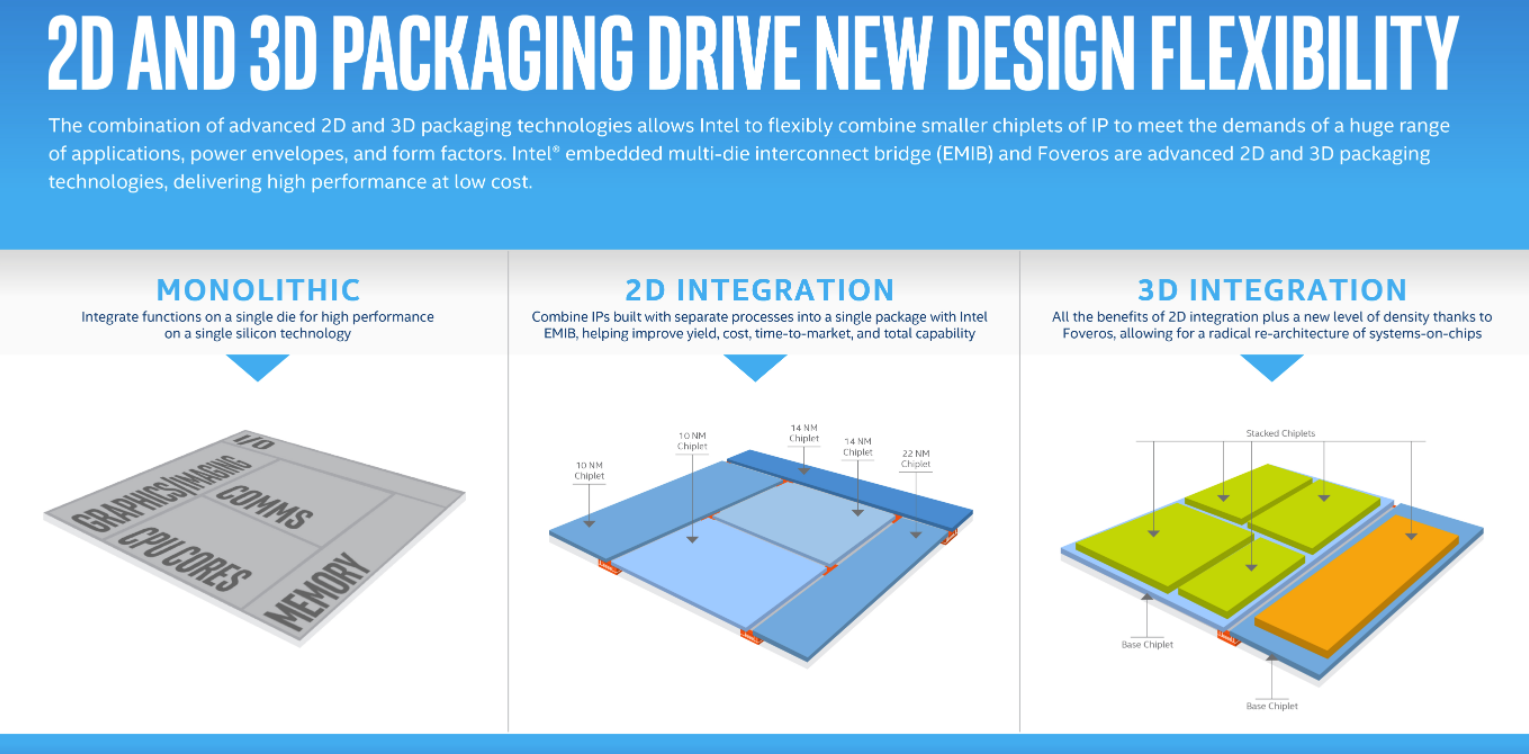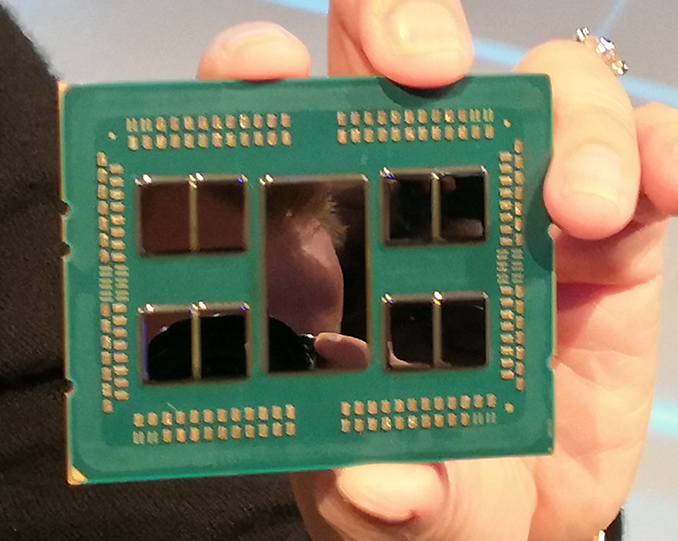Intel will release the processor with three-dimensional architecture Foveros in 2019
Just yesterday, we figured out why the media are claiming Intel’s loss of a dominant position in the market and how the company will be affected by the introduction of Amazon’s own server-side ARM processor, as representatives of the technology giant made another major announcement.
Intel has introduced a new three-dimensional CPU architecture called Foveros. In the second half of 2019, the technology giant plans to put on the market a new type of processors with a pitch of each layer of 10 nm and 22 nm, respectively. Clickable

Why is this announcement from Intel so important? Equipment manufacturers and specialists in the field have long been talking about slowing down the development of computing facilities and non-compliance with Moore's Law in the field of CPU. One of the reasons is the use of a single-layer architecture and the constant desire to simultaneously reduce the chip area, while increasing the number of transistors per square millimeter. At the same time, the transition to a three-dimensional architecture not only solves some of the issues with a further increase in computing power, but also opens the way for us to create full-fledged chiplets.
The term chiplet appeared not so long ago, and, to put it in simple terms, means a combined microchip that includes the CPU core, GPU, data ports and memory. This arrangement is quite promising, as it allows you to completely abandon the printed circuit boards as intermediaries between the main devices of the computer.
This is necessary because it is PCBs that are now the “bottleneck” of the entire PC or server architecture, since they significantly slow down the speed of data exchange between devices due to the greater resistance. You can read about the technology of chiplets and their advantages in this work .
The system of several computational layers has long been used in the manufacture of RAM. Back in the 90s, there were 4 and 6-layer memory chips, in which there were two working layers with cells for charge storage (bits), and the rest served as dividers between working zones. In fact, RAM is not a chiplet, since we are dealing simply with the layout of the structure, and not with a complex device that includes several different modules.

Intel's Foveros layout
Why is Intel using 22nm technology on one of its new processor layers? If CPU transistors scale well enough, which allows us to constantly reduce the process step, then with minimization, for example, of input-output ports, things are much worse. That is why the filling 10 nm rendered on a separate layer, and other elements that require a different step, carried away to the second layer 22 nm.
In addition, multi-layer architecture implies an increase in production costs, and if one of the layers can be saved by using an older and larger process technology without fatal performance losses, Intel will do it.
AMD also looked at the chiplet architecture, but so far only reached the announcement of the server CPU with a 7 nm process technology and the Fabrics substrate in 14 nm steps.

Product photo from the presentation.
This configuration was named “Chiplet Design”. And although representatives of the company called it a “chiplet” architecture, but this is evident in the presentation, the different elements of the server CPU are spaced apart in different parts of the substrate, that is, there is no layering. But even this arrangement inspires some confidence in the future development of computational tools.
In addition, AMD engineers have already presented their vision of a full-fledged chiplet, which includes all key computing units in one place:

The best scenario is the creation of a full-fledged microcomputer based on the three-dimensional architecture, enclosed in a classic CPU case familiar to us. If manufacturers achieve significant success in this area in the coming decades, then it is quite possible that the usual definition of a motherboard will disappear.
Since instead of the connecting link between the key elements of the computer, the motherboard of a three-dimensional chiplet will be exclusively a device for connecting peripherals and power, and all the main computing modules will be enclosed in the case of the chiplet itself.
Only the most important and probably uncomfortable question for manufacturers remains: how to cool it?
Intel has introduced a new three-dimensional CPU architecture called Foveros. In the second half of 2019, the technology giant plans to put on the market a new type of processors with a pitch of each layer of 10 nm and 22 nm, respectively. Clickable

Why is this announcement from Intel so important? Equipment manufacturers and specialists in the field have long been talking about slowing down the development of computing facilities and non-compliance with Moore's Law in the field of CPU. One of the reasons is the use of a single-layer architecture and the constant desire to simultaneously reduce the chip area, while increasing the number of transistors per square millimeter. At the same time, the transition to a three-dimensional architecture not only solves some of the issues with a further increase in computing power, but also opens the way for us to create full-fledged chiplets.
What is a chiplet
The term chiplet appeared not so long ago, and, to put it in simple terms, means a combined microchip that includes the CPU core, GPU, data ports and memory. This arrangement is quite promising, as it allows you to completely abandon the printed circuit boards as intermediaries between the main devices of the computer.
This is necessary because it is PCBs that are now the “bottleneck” of the entire PC or server architecture, since they significantly slow down the speed of data exchange between devices due to the greater resistance. You can read about the technology of chiplets and their advantages in this work .
Multi-layer architecture in computing and why Intel uses a different layer size.
The system of several computational layers has long been used in the manufacture of RAM. Back in the 90s, there were 4 and 6-layer memory chips, in which there were two working layers with cells for charge storage (bits), and the rest served as dividers between working zones. In fact, RAM is not a chiplet, since we are dealing simply with the layout of the structure, and not with a complex device that includes several different modules.

Intel's Foveros layout
Why is Intel using 22nm technology on one of its new processor layers? If CPU transistors scale well enough, which allows us to constantly reduce the process step, then with minimization, for example, of input-output ports, things are much worse. That is why the filling 10 nm rendered on a separate layer, and other elements that require a different step, carried away to the second layer 22 nm.
In addition, multi-layer architecture implies an increase in production costs, and if one of the layers can be saved by using an older and larger process technology without fatal performance losses, Intel will do it.
AMD related developments
AMD also looked at the chiplet architecture, but so far only reached the announcement of the server CPU with a 7 nm process technology and the Fabrics substrate in 14 nm steps.

Product photo from the presentation.
This configuration was named “Chiplet Design”. And although representatives of the company called it a “chiplet” architecture, but this is evident in the presentation, the different elements of the server CPU are spaced apart in different parts of the substrate, that is, there is no layering. But even this arrangement inspires some confidence in the future development of computational tools.
In addition, AMD engineers have already presented their vision of a full-fledged chiplet, which includes all key computing units in one place:

Prospects for chiplet technology and three-dimensional architecture
The best scenario is the creation of a full-fledged microcomputer based on the three-dimensional architecture, enclosed in a classic CPU case familiar to us. If manufacturers achieve significant success in this area in the coming decades, then it is quite possible that the usual definition of a motherboard will disappear.
Since instead of the connecting link between the key elements of the computer, the motherboard of a three-dimensional chiplet will be exclusively a device for connecting peripherals and power, and all the main computing modules will be enclosed in the case of the chiplet itself.
Only the most important and probably uncomfortable question for manufacturers remains: how to cool it?
